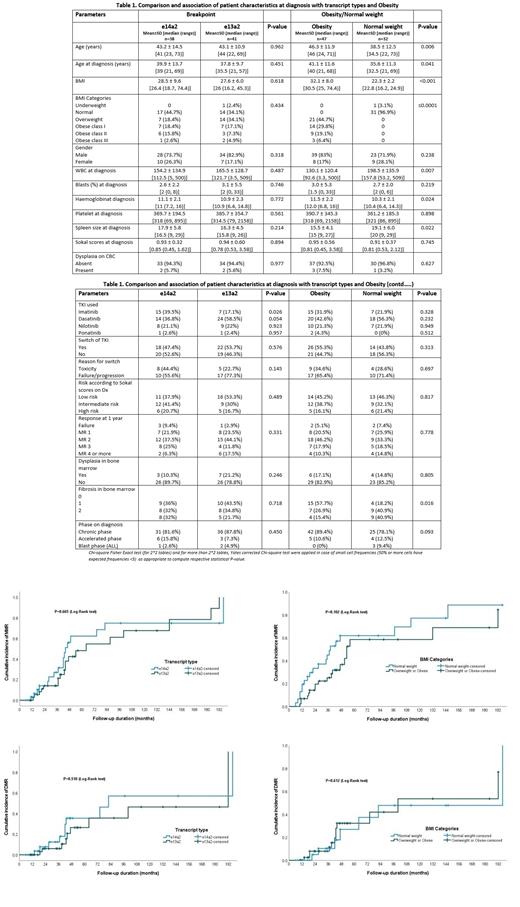Abstract
Introduction
The hallmark of CML is BCR-ABL1 (breakpoint cluster region gene-Abelson murine leukemia viral oncogene homolog 1) on Philadelphia chromosome, which is the result of a reciprocal translocation between the long arms of chromosomes 9 and 22 (t[9;22][q34;q11]) [1].
Chromosome 22 breakpoints influence the BCR portions preserved in the BCL-ABL1 fusion mRNA and protein and are mainly localized to one of three BCRs, namely major-BCR (M-BCR), minor BCR (m-BCR) and micro-BCR (µ-BCR). In comparison, breaks in chromosome 9 arise most frequently by alternative splicing of the two first ABL1 exons, and can also be generated in a large genetic region, upstream of exon Ib at the 5' end, or downstream of exon Ia at the 3' end. In the majority of CML cases, the breakpoint lies within the M-BCR and gives rise to e13a2 or e14a2 fusion mRNAs (previously denoted as b2a2 and b3a2) and a p210BCR-ABL fusion protein [2]. [3]
Methodology
We conducted a retrospective analysis of the files of 79 patients being treated in our center for CML with known BCR-ABL1 breakpoints; there were few more patients with known transcript type but excluded because either travelled immediately on diagnosis or had a failure due to confirmed compliance issues. Patients' management and response assessment was done based on ELN 2013 guidelines. The analysis is done based on two main groups, obese versus normal BMI, and then based on BCR-ABL1 transcripts: e13a2 versus e14a2. Ethical approval was obtained from Medical Research Center for Hamad Medical Corporation (MRC-01-18-337).
Results
Patients included 62 males (78.5%) and 17 females (21.5%) with the mean age at diagnosis 38.8±11.8 years (median, 38; range 21 to 69 years).
The characteristics (demographics, anthropometric, hematological and clinico-pathological) of the patients and their association with transcript types and obesity are summarized in Table 1.
Patient outcomes, cytogenetic and molecular responses
The median follow-up was 30 months (range 6 to 196 months) and 38 months (range 3 to 192 months) in normal weight and obesity groups, respectively. The median follow-up was 28 months (range 3 to 196 months) and 39 months (range 10 to 192 months) in e14a2 and e13a2 patients, respectively. A total of 22 patients distributed among different groups ended up leaving the country (censored) after a variable duration of follow-up (6 - 196 months), 18 of them CML-CP, and 4 CML-AP.
3 patients died in our cohort, all of them had e14a2 transcript, one of them was in the normal weight/BMI group, two were in the obesity group.
In e14a2 group, more patients were on imatinib at the time of analysis (15 (39.5%) vs 7 (17.1%) in e13a2 group, p = 0.026). The percentage of patients of had to switch TKI was similar in both groups (47.4% vs 53.7%, p = 0.576). However, less patients in e14a2 group had to switch TKI because of failure/progression (10 (55.6%) vs 17 (77.3%), p = 0.145); however, this didn't translate into a significant difference of achieving MMR at 1 year, where in e14a2 group, 10 patients achieved MMR at 1 year (31.3%), same as in e13a2 group (10 patients = 29.3%) p 0.331 (all shown in table 1).
When comparing long-term outcomes, there was also no significant difference between groups based on transcript type with regards to MMR (44.7% vs 46.3% in e14a2 vs e13a2 respectively) or DMR (26.3% vs 22% respectively) as shown in figure.
In the obesity group, there were 2 patients using ponatinib due to T315I mutation, compared to none in normal weight group. However, there were no significant differences in TKI used, switch of TKI, or reason for switch. Same applies for achieving MMR at 1 year, as 11 patients in the obesity group achieved MMR (28.2%) compared to 9 patients in normal weight group (33.3%), p = 0.778 (as shown in table 1).
Regarding the long-term outcomes, more patients in the obesity group achieved MMR (53.2%) compared to normal weight group (34.3%), and this response was faster, but not statistically significant. This difference was less clear with regards to DMR (25.5% in the obesity group compared to 21.9% in normal weight group) as shown in figure.
Conclusion
In the patient-cohort studied there were no significant differences in molecular response based on transcript type or body weight/BMI.
No relevant conflicts of interest to declare.


This feature is available to Subscribers Only
Sign In or Create an Account Close Modal